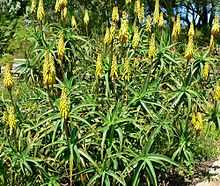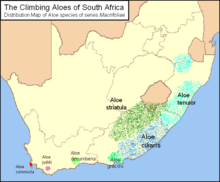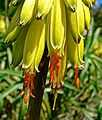Aloe striatula
| Aloe striatula | |
|---|---|
 | |
| Scientific classification | |
| Kingdom: | Plantae |
| Clade: | Angiosperms |
| Clade: | Monocots |
| Order: | Asparagales |
| Family: | Xanthorrhoeaceae |
| Subfamily: | Asphodeloideae |
| Genus: | Aloe |
| Species: | A. striatula |
| Binomial name | |
| Aloe striatula Mill. | |
 | |
Aloe striatula (the Hardy Aloe) is a sturdy climbing aloe that naturally occurs on the summits of mountains along the south of the Karoo region of South Africa. Tough and hardy, with orange-yellow flowers, it is a popular plant in gardens around the world.
Appearance

Aloe striatula is a robust rambling Aloe that can form a large shrub of up to 2 meters in height. It is closely related to Cape Town's Aloe commixta, but it is easily distinguished from it by the distinctive dark green stripes on the stems and leaf sheathes (its species name, striatula, means "little stripes"), and by its thin, recurved leaves (which, like its flowers, are more densely packed). The leaves of striatula are dark green and strongly recurved, with numerous small white teeth along their margins.
The flowers are orange-to-yellow and appear densely on tall(400mm), un-branched, cone-shaped racemes throughout the summer.
The unique Caesia variety of this species - found only around Molteno in the Eastern Cape - has milky-green leaves and bright yellow flowers. [1]
Distribution
Aloe striatula naturally occurs in the mountains of the Karoo region of South Africa, between the towns of Graaf-reinet and Queenstown in the Eastern Cape. It is very tough and hardy however and has been planted widely in gardens - in South Africa and around the world.
Although closest to the rare and unique Aloe commixta of Table Mountain, Aloe striatula is part of a whole group of related climbing aloes that grow throughout Southern Africa, the "Macrifoliae" Aloes. Other species in this group are: Aloe ciliaris, Aloe tenuior, Aloe gracilis, Aloe juddii, Aloe decumbens, and of course commixta and striatula itself. [2]
Growing Aloe striatula
One of the hardiest of aloes, it will grow just about anywhere, and is even known commonly as "The Hardy Aloe". It will tolerate much colder temperatures than most Aloes, including frost and even some light snow, but it prefers full sun and well-drained soil. In the Eastern Cape it is often planted along the boundaries of kraals, as it naturally forms a well-shaped and hardy hedge. Like other climbing aloes, it can easily be propagated by cuttings(truncheons) as well as by seed.
The plant's Latin species-name "striatula" means "little stripes", and refers to the thin dark-green stripes that can be seen on the plant's leaf sheaths. Due to their similar species names, striatula is often confused in literature with the similarly named Aloe striata ("Coral Aloe").[3]
Pictures
See also
References
| Wikimedia Commons has media related to Aloe striatula. |
- ↑ Smith, G.F. & Van Wyk, B.-E. 2008. Aloes in Southern Africa. Struik, Cape Town. ISBN 978-1-875093-04-5.
- ↑ Reynolds, G.W. 1950. The aloes of Southern Africa. Balkema, Cape Town.
- ↑ http://www.succulents.co.za/aloes/rambling-aloes/index.php


